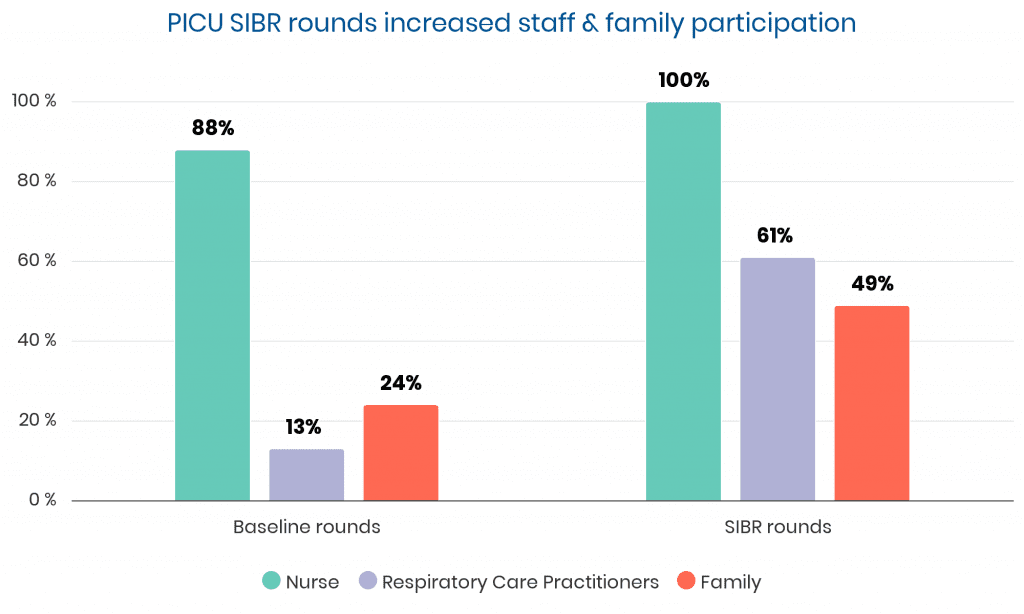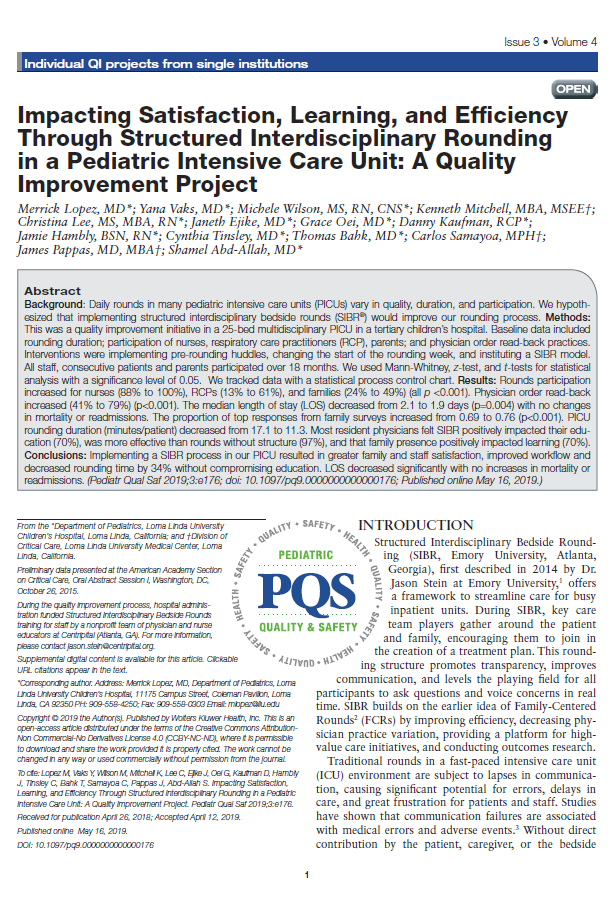Impacting Satisfaction, Learning, and Efficiency Through Structured Interdisciplinary Rounding in a Pediatric Intensive Care Unit


Overview
In a study conducted at Loma Linda University Children’s Hospital, the implementation of Structured Interdisciplinary Bedside Rounds (SIBR) in a Pediatric Intensive Care Unit (PICU) improved family and staff satisfaction, workflow efficiency, and resident education.
Objectives
To assess the impact of Structured Interdisciplinary Bedside Rounds (SIBR) on rounding efficiency, interdisciplinary participation, family satisfaction, and resident education in a PICU.
Methods
The study was a quality improvement initiative conducted in a 25-bed multidisciplinary PICU over 18 months. Interventions included pre-rounding huddles, changing the start of the rounding week, and implementing the SIBR model. Data were collected on rounding duration, interdisciplinary participation, family satisfaction, and physician order read-back practices. Statistical analysis included Mann-Whitney, z-test, and t-tests.
Results
Rounding Duration
• Decreased from 17.1 minutes per patient to 11.3 minutes per patient (P<0.001).
Interdisciplinary Participation
• Nurses: Increased from 88% to 100% (P<0.001).
• Respiratory Care Practitioners (RCPs): Increased from 13% to 61% (P<0.001).
• Families: Increased from 24% to 49% (P<0.001).
Physician Order Read-Back
• Increased from 41% to 79% (P<0.001).
Length of Stay (LOS)
• Decreased from a median of 2.1 days to 1.9 days (P=0.004).
Family Satisfaction
• Proportion of top responses from family surveys increased from 0.69 to 0.76 (P<0.001).
Resident Education
• 70% of residents felt SIBR positively impacted their education.
• 97% found SIBR more effective than rounds without structure.
• 70% believed family presence positively impacted learning.
Conclusion
The implementation of SIBR in a PICU led to greater family and staff satisfaction, improved workflow efficiency, and enhanced resident education. SIBR reduced rounding time without compromising the quality of care, mortality, or readmission rates, indicating its value in a busy pediatric intensive care environment.
Additional Data


5.8 minute decrease in mean rounding duration per patient (p < 0.001)


SIBR rounds had significantly better nurse, respiratory care practitioner and family participation: 14% increase in for nurses, 369% for (RCPs) & 104% for family (p < 0.001)
I hope you enjoyed reading these strong results. Unit outcomes like these are achievable within 3 to 6 months using a seasoned implementation methodology:
- skillful project management
- smooth training and launch, and a
- long-term partnership for sustainability.
One option to achieve similar results is to engage our 1Unit experts. Backed by 15 studies like this one, our work has received awards from The Joint Commission, CMS, Clinical Excellence Commission, IHI, BMJ, and the Society of Hospital Medicine.
Whether your unit(s) have current multidisciplinary rounds or not, our experts can guide your unit leaders to launch and sustain the best interdisciplinary teamwork and communication you’ve ever seen on a hospital ward.
This is not some ivory tower theory. Our methods have been toughened and refined worldwide. Everything we teach has been carefully tested over more than a decade, so we know it works.
Connect with us if you’d like the “Easy Button” to steadily reduce harm events, discharge delays, and patient and staff dissatisfiers.
Liam Chadwick, PhD


